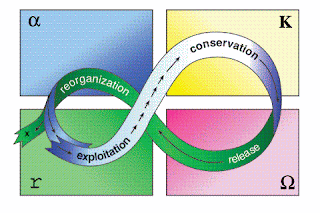Resilience: Ecology, Evolution, and Engineering
The concept of resilience is key to BES III. This powerful concept is ideal for understanding and working with complex, human ecosystems. However, it is the object of some confusion because there are two contrasting ways to frame and theorize the concept.
Originally, engineering and physical systems were the source of the concept as applied in ecology. Under the equilibrium paradigm predominant at the time, resilience was conceived of as the ability of a system to absorb a shock or deformation and to return to its original, or equilibrium, state. A rubber band is a perfect example of such a system. The loose, floppy form can be stretched repeatedly, and still return to its general band-like shape.
Engineering or equilibrium resilience is the concept used to describe this dynamic. This sort of resilience can be called engineering resilience because it characterizes built structures and infrastructure. Key to this idea is that there is an acceptable, desired, or equilibrium state of the system. Of course, extreme deformation or perhaps consistent strong deformation over time can lead to system failure. The band breaks when stretched too far, or after years of material degradation while encircling a thick wad of forgotten papers in a hot attic.
Equilibrium or engineering resilience may be of value when it is possible to identify a desirable state that is expected to persist over some specified time or at a particular spatial scale. But for many purposes, it is best considered a special case of the concept of resilience. A more inclusive concept suitable to systems that are not at equilibrium, or which are undergoing periodic or constant change is ecological or evolutionary resilience.
Ecological resilience does not ask whether a complex system returns to a previous or equilibrium state. Rather, it asks about the changes that a system can experience and still persist in the same dynamic form. Resilience is about the ability to receive shocks and still stay in the game. Systems that can adapt to change are said to be resilient. This then is an evolutionary kind of concept since adaptation is a central feature. This is in contrast to engineering resilience which is concerned with stability or permanence. So, ecological and evolutionary resilience are concerned with adaptive capacity and adjustment to change, not to return to a stable point. Rather than asking about the ability of a rubber band to return to its unstressed state, evolution asks about the rubber band becoming something else that is better adapted to the new conditions. It is of course silly to think about a simple, physical-chemical system such as a rubber band changing in such a radical way, but evolution, adaptation, learning, and adjustment are familiar capacities of biological and social systems. In other words, they are complex systems that can adapt. Resilience in the more evolutionary sense is the idea that points toward the question of how — and how well — a particular system can adapt to changing conditions or sudden shocks that come at unexpected times.
Changing concepts of resilience are relevant to the BES III main theme of Sanitary to Sustainable City. The sanitary city identifies a desired state, and seeks to keep structures or processes at that level. Given that societal and regulatory decisions identify legal or desirable targets for some features people must manage, a classical or engineering definition provides guidance about how to measure success. However, under changing environmental conditions, including social, economic, and environmental alterations, it may be more appropriate to ask about the capacity of the system to adjust to those changes. Recognizing that feedbacks among social, economic, and environmental factors and processes are an unavoidable part of urban ecosystems, this suggests that we learn how to go beyond the engineering resilience concept and understand and use the contemporary concept of ecological or evolutionary resilience.
Here are some references about this contrast and the nature of ecological resilience that are relevant to socio-ecological systems.
Gunderson, L. H. 2000. Ecological resilience – in theory and application. Annual Review of Ecology and Systematics 31:425-439.
Holling, C. S. 1996. Engineering resilience versus ecological resilience. Pages 31-44 in P. C. Schulze, editor. Engineering within ecological constraints. National Academies of Engineering, Washington, DC.



